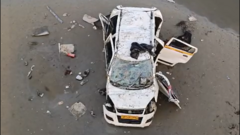The accident poses significant questions regarding the responsibilities of technology within societal frameworks. With navigation apps like Google Maps often seen as the go-to guide for travelers across India—boasting around 60 million active users—a tragic error has now led to tragic consequences. Authorities are currently investigating and have filed charges against officials from the state road department and Google Maps.
Further complicating the issue is the way these navigation services gather and disseminate information regarding road conditions. Experts explain that while user data provides insights into traffic patterns and obstacles, the sheer scale of India's infrastructure challenges makes it difficult for these apps to remain current. The lack of a reliable system for logging infrastructural changes also exacerbates the risks faced by users.
Legal interpretations around the liability of apps also vary. While some argue that platforms like Google Maps are afforded protection under India's IT Act, there are indications that they could still be liable for negligence if it can be shown that they failed to act upon accurate information regarding road closures or dangers.
As this tragic event unfolds, it serves as a sobering reminder of the intersection between technology reliance and road safety, exposing the urgent need for improved infrastructure and communication within rapidly developing nations.
Further complicating the issue is the way these navigation services gather and disseminate information regarding road conditions. Experts explain that while user data provides insights into traffic patterns and obstacles, the sheer scale of India's infrastructure challenges makes it difficult for these apps to remain current. The lack of a reliable system for logging infrastructural changes also exacerbates the risks faced by users.
Legal interpretations around the liability of apps also vary. While some argue that platforms like Google Maps are afforded protection under India's IT Act, there are indications that they could still be liable for negligence if it can be shown that they failed to act upon accurate information regarding road closures or dangers.
As this tragic event unfolds, it serves as a sobering reminder of the intersection between technology reliance and road safety, exposing the urgent need for improved infrastructure and communication within rapidly developing nations.




















